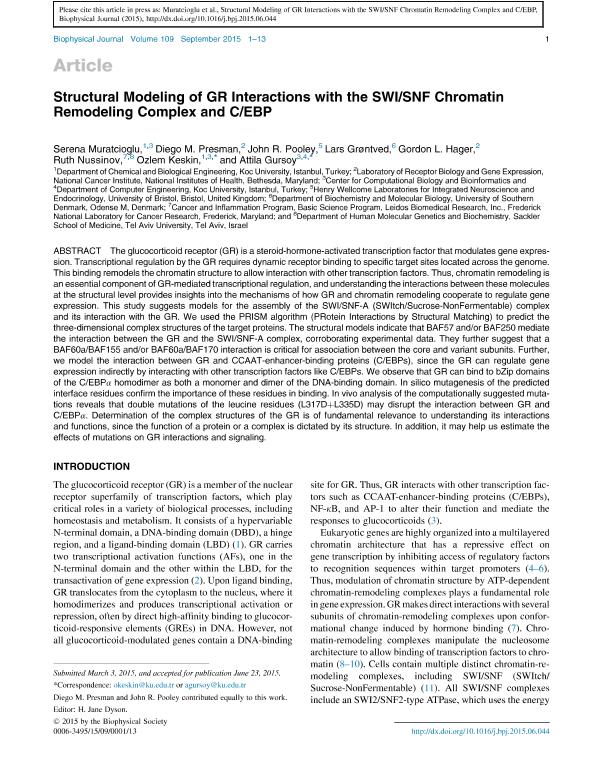Artículo
Structural Modeling of GR Interactions with the SWI/SNF Chromatin Remodeling Complex and C/EBP
Muratcioglu, Serena; Presman, Diego Martin ; Pooley, John R.; Grøntved, Lars; Hager, Gordon L.; Nussinov, Ruth; Keskin, Ozlem; Gursoy, Attila
; Pooley, John R.; Grøntved, Lars; Hager, Gordon L.; Nussinov, Ruth; Keskin, Ozlem; Gursoy, Attila
 ; Pooley, John R.; Grøntved, Lars; Hager, Gordon L.; Nussinov, Ruth; Keskin, Ozlem; Gursoy, Attila
; Pooley, John R.; Grøntved, Lars; Hager, Gordon L.; Nussinov, Ruth; Keskin, Ozlem; Gursoy, Attila
Fecha de publicación:
09/2015
Editorial:
Cell Press
Revista:
Biophysical Journal
ISSN:
0006-3495
Idioma:
Inglés
Tipo de recurso:
Artículo publicado
Clasificación temática:
Resumen
The glucocorticoid receptor (GR) is a steroid-hormone-activated transcription factor that modulates gene expression. Transcriptional regulation by the GR requires dynamic receptor binding to specific target sites located across the genome. This binding remodels the chromatin structure to allow interaction with other transcription factors. Thus, chromatin remodeling is an essential component of GR-mediated transcriptional regulation, and understanding the interactions between these molecules at the structural level provides insights into the mechanisms of how GR and chromatin remodeling cooperate to regulate gene expression. This study suggests models for the assembly of the SWI/SNF-A (SWItch/Sucrose-NonFermentable) complex and its interaction with the GR. We used the PRISM algorithm (PRotein Interactions by Structural Matching) to predict the three-dimensional complex structures of the target proteins. The structural models indicate that BAF57 and/or BAF250 mediate the interaction between the GR and the SWI/SNF-A complex, corroborating experimental data. They further suggest that a BAF60a/BAF155 and/or BAF60a/BAF170 interaction is critical for association between the core and variant subunits. Further, we model the interaction between GR and CCAAT-enhancer-binding proteins (C/EBPs), since the GR can regulate gene expression indirectly by interacting with other transcription factors like C/EBPs. We observe that GR can bind to bZip domains of the C/EBPα homodimer as both a monomer and dimer of the DNA-binding domain. In silico mutagenesis of the predicted interface residues confirm the importance of these residues in binding. In vivo analysis of the computationally suggested mutations reveals that double mutations of the leucine residues (L317D+L335D) may disrupt the interaction between GR and C/EBPα. Determination of the complex structures of the GR is of fundamental relevance to understanding its interactions and functions, since the function of a protein or a complex is dictated by its structure. In addition, it may help us estimate the effects of mutations on GR interactions and signaling.
Palabras clave:
Glucocorticoids
,
Cebp
,
Prism
,
Chromatin Remodeling
Archivos asociados
Licencia
Identificadores
Colecciones
Articulos(IFIBYNE)
Articulos de INST.DE FISIOL., BIOL.MOLECULAR Y NEUROCIENCIAS
Articulos de INST.DE FISIOL., BIOL.MOLECULAR Y NEUROCIENCIAS
Citación
Muratcioglu, Serena; Presman, Diego Martin; Pooley, John R.; Grøntved, Lars; Hager, Gordon L.; et al.; Structural Modeling of GR Interactions with the SWI/SNF Chromatin Remodeling Complex and C/EBP; Cell Press; Biophysical Journal; 109; 6; 9-2015; 1227-1239
Compartir
Altmétricas



